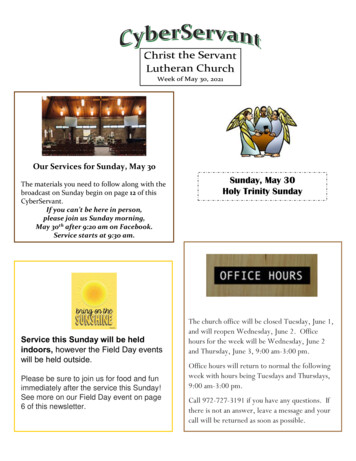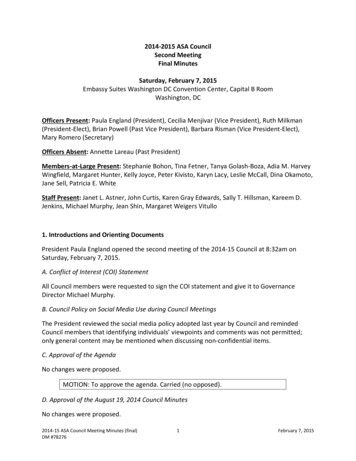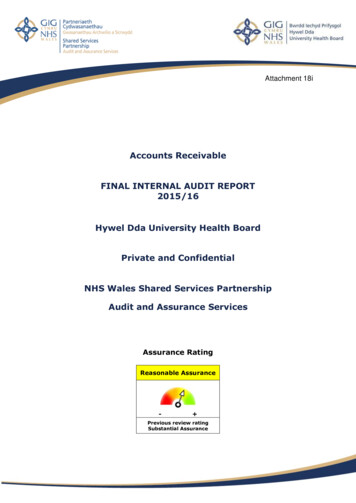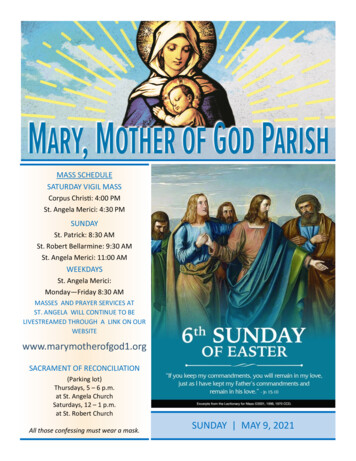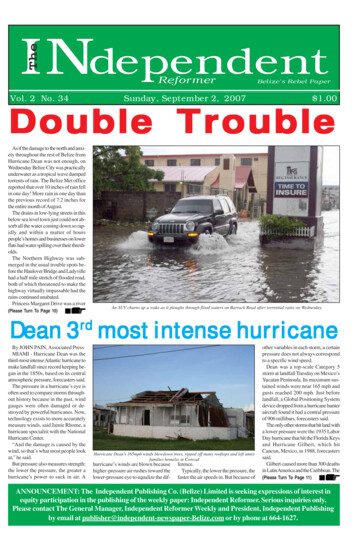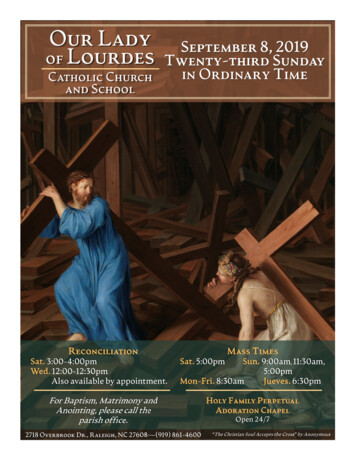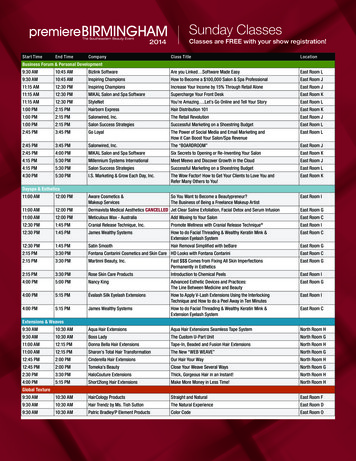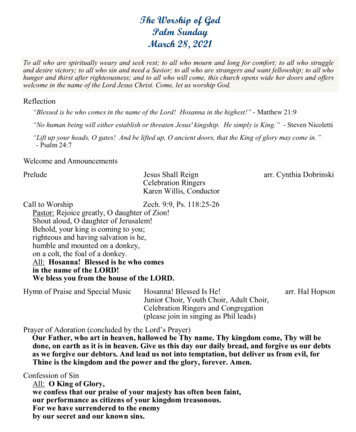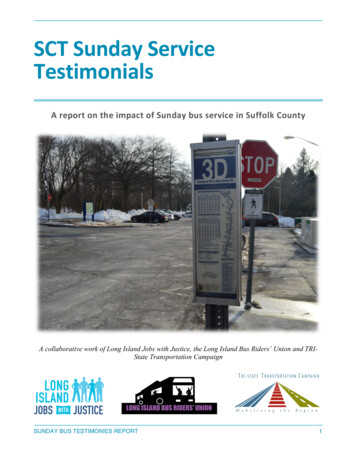
Transcription
ndaybusserviceinSuffolkCountyA collaborative work of Long Island Jobs with Justice, the Long Island Bus Riders’ Union and TRIState Transportation CampaignSUNDAY BUS TESTIMONIES REPORT1
INTRODUCTIONSuffolk County receives far less in State Transit Operating Assistance (STOA) for its bus system whencompared to neighboring Nassau and Westchester Counties. New York State’s funding contributionsonly make up roughly 30 percent of Suffolk County Transit’s operating budget, while comprising over50 percent and 40 percent of the operating budgets of Nassau Inter-County Express (NICE) andWestchester’s Bee Line service, respectively. To begin to make up for this imbalance, Suffolk Countyshould receive 10 million more in additional STOA funding.When Suffolk County receives additional funding it puts it to its intended purpose. In 2013, SuffolkCounty received roughly 2 million in additional state and federal transit funding. This funding wasdedicated to the expansion of Sunday service along 10 routes with the highest ridership. Those routesconsisted of the following: S1, S33, S40, S41, S54, S58, S66, S92, 3D and 10C. Since launching inJanuary 2014, this service as proven tremendously popular. Through mid-June of this year, ridershipon these routes had grown by almost 200 percent and by the end of the year majority of the newSunday lines saw ridership increase by 300 percent to 600 percent.Suffolk County bus service is increasing in popularity. In 2013 alone, nearly 6.5 million trips weretaken on Suffolk County Transit. According to the National Transit Database, ridership on SuffolkCounty Transit has increased by approximately 30 percent since 2000.Bus service on Long Island is a boon for the economy. A recent economic impact analysis conductedby Appleseed, Inc. and New York University’s Rudin Center for Transportation Policy and Researchfound that bus service in Nassau County accounted for approximately 1,490 jobs and 191.5 million ineconomic output in 2012. Closer to home in Suffolk County, Tri-State Transportation Campaign foundthat 30 driver and mechanic jobs were created as a result of the 2 million in state and federal fundinginvested into Sunday service that began in 2014.It is apparent that more service is needed. Despite these gains in ridership and service improvements,over 80 percent of the system lacks access to Sunday service, which in turn, prevents Suffolk CountyAccessible Transit (SCAT) from operating as well. Federal law requires that on-demand para-transitservice be offered within a quarter of a mile of fixed-route bus service. In the areas that do not haveSunday service, para-transit service is not provided to Suffolk County residents that day of the week.In addition, the Suffolk County Welfare to Work Commission has recommended that bus service alsobe expanded further into evenings, a service that does not exist past 8 pm on a majority of routes.Although implementation of Sunday bus service provided some commuters with an alternative to moreSUNDAY BUS TESTIMONIES REPORT2
costly modes of transportation, like taxis and personal vehicles and also expanded access to majorbusiness centers, like local downtowns and malls, and to employment and employment opportunities,there are still many residents who cannot access the service.The purpose of this report is to highlight actual bus rider testimonies to demonstrate the effectivenessof Sunday service while also supplementing recommendations on how to further grow the system.Rider testimonies provide insight into the real life situations and experiences that occur when utilizinga public transportation system and should be used when discussing large service changes to any publicsystem. It is our hope that this report will act as a supplement to assist in advocating for additionalState funding that will help expand and maintain SCT.BUSRIDERTESTIMONIESBefore the implementation of Sunday service, many residents who solely relied on publictransportation were limited to where and when they could travel; however, with its introduction, busriders have witnessed their access to many services, jobs, and consumer options expand. The followingstatements are a collection of Sunday bus rider testimonies that reveal the opportunities Sunday servicehas provided and the unmet needs that still remain.Gary Davis rides the S29. He is a member of the Upper Room Christian World center and is an avidbus rider and attends church regularly. His testimony demonstrates how inactive bus lines in Suffolkaffect the community:“I've had good experiences with SCT and I was thrilled to heard about Sunday service but Irealized there was an S29 bus stop outside of my church that was inactive. My church serves alot of communities that can't access our services due to transportation challenges. I'm a busrider who has never been able to get to church without assistance from others. There is a pentup, unsatisfied need for Sunday service for the S29, if expanded it would be a 'win-win' for allinvolved”Sunday service has helped riders like Angela Gloudon; however, at times she is still forced to rely onher bike to get her around:“I'm happy the S66 runs on Sundays now, I just wish there were more buses on Sunday and atnight. I take the bus to go shopping and since the S68 doesn't run on Sundays I have to ride mybike to the nearest bus stop, which makes it hard to get around, especially in the winter.”Lee Ann rides the 7B and S66. She is a single mother with a two-year old child who rides the buses totake her daughter to programs and classes. They currently live at Help Suffolk, a shelter for transient orhomeless individuals:“I schlep with a child, a stroller, groceries and with my back issues. Accessibility is a majorconcern. My daughter and I are technically 'homeless' and though I can get to places, likeprograms and classes for her at the library, getting back is almost impossible. Her programshave been running later and later and with this weather I can't afford to walk.”SUNDAY BUS TESTIMONIES REPORT3
As required by the Americans with Disabilities Act (ADA), para-transit services can only operatealong existing and running fixed route lines. Before the implementation of Sunday service, those whorelied on SCAT (Suffolk County Accessible Transportation) were homebound, unable to leave theirresidences unless they found other means of transportation. Suffolk County has over 280,000 residentswith disabilities (Suffolk County), 30,000 more than Nassau County. The development of Sundayservice provided expanded freedoms and opportunities for disabled residents.Cliff rides the S66 and lives with Diabetes. His illness forced him to become dependent on publictransportation. The implementation of Sunday service on his bus route changed his life. This is Cliff’stestimony:“I am so grateful for Sunday service. Due to my severe Diabetes, I was forced to stop drivingearly and rely on the buses to get everywhere. It wasn't until the new Sunday service that I waseven able to spend time with my son on the weekends. It's because of the Long island BusRiders' Union that I can finally take him to the movies or teach him how to fish and his mothercan finally have some time to herself. I get an extra day to spend with my son without the fearof not having a ride to get him home on Sunday or to school on Monday, and it's all thanks tothe Bus Riders' Union.”Kenneth Noelsch Jr. is a disabled bus rider who lives in Central Islip. His testimony is reflects on thelimitations that continue to exist for disabled bus riders:“I lost my car about 15 years ago due to issues with my legs. I ride the bus almost everyday butI can't access Sunday buses because the nearest stop is over a half a mile from my house and Ican't get there. The Sunday service is a good idea but I don't feel like its being operatedefficiently.”There is a direct correlation between access to public transportation and an individual’s access toemployment and educational opportunities (Graves). Bus riders who work in retail and food servicejobs, like clothing stores and supermarkets, are often required to work flexible or late hours on theweekends. Before Sunday service, many workers needed to find alternative means of transportation(ex. calling a taxi service) that are often more expensive than public transportation.Sarraline Bahomnde is a Veteran who works on the weekends at the Smithhaven Mall. She is also oneof thousands of individuals who cannot access Sunday bus service:“The Sunday service is good to get to the [Smithaven] Mall but only if you're near a stop.When I work on Sundays I either have to walk over an hour from my house in Centereach to thenearest 3D bus stop or pay 15 for a taxi. Neither is great, especially since I was almost hit bya car while walking to the bus stop.but what can I do?”Walter rides the S92. He is a worker at a local supermarket who struggled to get to work on Sundays:“The buses, from what I've seen, have been getting better! They're more convenient and evenrun on Sundays now. I usually work on Sunday, so this has made my life so much easier. I'veeven started telling my friends that they should ride the bus too and stop wasting all that gas.SUNDAY BUS TESTIMONIES REPORT4
It’s not perfect though. I wish the buses would run later at night. I would like to work morenight hours but I can't unless I find a ride from a co-worker.”IMPACTONLONGISLANDCOMMUNITIESMany community organizations like Vision Long Island, who represents the Long Island BusinessCouncil and the Long Island Smart Growth Working Group, are in support of Sunday serviceexpansion. At a time when communities are looking to lower their carbon footprint and providesupport to small businesses, we need to focus on the ways that we can highlight Suffolk County as adestination. Transportation systems that provide service everyday of the week are vital to this growth.Eric Alexander, Director of Vision Long Island, has worked with many local business owners andcommunity members around the expansion of service in Suffolk County. Vision Long Island advancesmore livable, economically sustainable, and environmentally responsible growth on Long Islandthrough Smart Growth. He contributed this testimony about Sunday service:“We believe that this increase in service is crucial for a substantial number of riders. Currentlymany riders cannot rely on the bus to get home from jobs that have evening hours or requirethem to work on Sundays, which many service jobs do. Instead they rely on cabs or othermeans of travel. This increase will cost less to those riders than cab fare or having to forgoshifts or better paying jobs because they would not have reliable transportation to get there.Sunday service would provide an improvement in the quality of life for many of its ridersincluding the low to moderate income, seniors, millennials, disabled, and veterans who rely onbus service as their main source of transportation. The service not only allows for employees toget to work on Sundays, it also allows access for customers to patron many of our smallbusinesses. Many of the Sunday riders would also rely on the service to attend church services.Without Sunday service, seniors who rely on the bus for social activities are left with no way toget around.Particularly important to remember, bus services are generally the only form of North/Southconnectors for public transportation throughout Suffolk County. The buses also connect ourdowntowns and allow for commuters to travel throughout Suffolk without relying on otherforms of transportation. However, the system lacks the convenience of evening and Sundayservice for Suffolk County residents as well as access for our neighbors to the west in NassauCounty.”Samantha is a manager at Hallmark in the Smithhaven Mall and although she is not a bus rider she hasseveral employees who ride the bus:“I don't use the buses but I've definitely noticed a difference. There is more traffic going intothe mall on Sunday's than ever.”Steven Siegalwaks is the owner/proprietor of Green Earth Natural Foods Market in Riverhead. Healso was not a bus rider but was aware of its expansion and positive impact:SUNDAY BUS TESTIMONIES REPORT5
“I don't really deal with the buses but I have heard that it's been getting better. I think for aplace as big and shaped the way Long Island is, it's imperative that we continue to grow thebuses and I hope that they do keep expanding and adding more service.”Legislator Jay Schniederman, who represents Suffolk County District 2, was instrumental in thedevelopment of Sunday service in both 2011 and 2013. As a local elected official he has seen thepositive effects of Sunday service in his community and understands the importance of a robust,affordable and effective public bus system:“Public transportation is essential. ‘No bus’ means ‘no work’ for many people. Not everyonecan afford car payments, insurance, repairs and gasoline. Years ago, during the days of the"blue laws", retail business were closed on Sundays. Those days are long gone. Sundays arebusy working days, particularly in areas where tourism is a big part of the economy. But it wasnot until recently that Suffolk County began to offer limited Sunday service. Only about one outof five bus lines now run on Sundays. We've seen ridership levels grow consistently on theselines and we've had many requests to add additional lines. But the County simply doesn't havethe money to bring the system up to the needed service levels. We'll be adding a few more linesthis Spring with revenue from a twenty five cent fare increase, but the answer is not from farehikes. We need additional State funds to help cover the costs of Sunday service. Many routesalso need to run later into the evening so that people can get home from work.”CONCLUSIONANDRECOMMENDATIONSImplementing Sunday bus service had, and continues to have, a significant impact on the lives ofSuffolk C
service be offered within a quarter of a mile of fixed-route bus service. In the areas that do not have Sunday service, para-transit service is not provided to Suffolk County residents that day of the week. In addition, the Suffolk County Welfare to Work Commission has recommended that bus service also be expanded further into evenings, a service that does not exist past 8 pm on a majority of .
